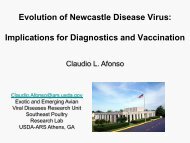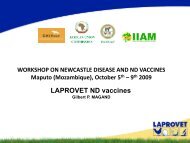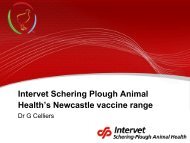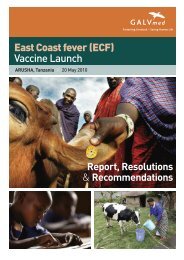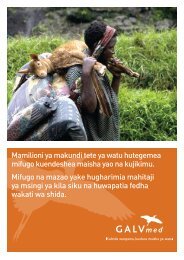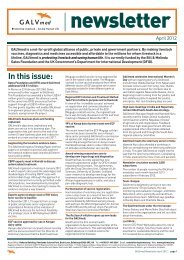A Path to Prosperity New Directions for African Livestock
GALVmed Impetus Strategy Paper
GALVmed Impetus Strategy Paper
- No tags were found...
You also want an ePaper? Increase the reach of your titles
YUMPU automatically turns print PDFs into web optimized ePapers that Google loves.
Others felt there needed <strong>to</strong> be continued emphasis<br />
on building capacity and demand from community<br />
level using techniques such as participa<strong>to</strong>ry learning<br />
and action.<br />
Several contribu<strong>to</strong>rs called <strong>for</strong> greater recognition<br />
of the role that working animals 1 play in supporting<br />
peoples’ livelihoods. For example, “in very many<br />
farming systems, draught animals are an integral<br />
part of the system – bringing chemical inputs, seeds<br />
etc <strong>to</strong> the farm and fields, transporting fodder <strong>to</strong><br />
lives<strong>to</strong>ck in cut and carry systems and transporting<br />
lives<strong>to</strong>ck and crop products <strong>to</strong> markets . How many<br />
small scale dairy farming systems could get<br />
sufficient quantities of fresh milk <strong>to</strong> collecting<br />
centres without the use of pack or cart donkeys?<br />
How do famers get sick animals <strong>to</strong> access vet<br />
services? Often on the back of a donkey cart?<br />
How do vegetables or even coffee <strong>for</strong> export start<br />
their journey <strong>to</strong> market? Often on pack animals<br />
acting as the first point on the marketing chain”.<br />
It was also noted that working equines, particularly<br />
donkeys, make a significant contribution <strong>to</strong> peoples'<br />
resilience during times of drought. However this is<br />
rarely recognised by humanitarian aid agencies<br />
when they plan and implement relief work.<br />
It was argued that working animals are working<br />
under-potential because they seem mainly ignored,<br />
their contribution massively under-valued by<br />
extension and health services, and by development<br />
NGOs. Little attention is given <strong>to</strong> their good<br />
management and nutrition, working practices,<br />
harness (design, fitting, repair, management, use)<br />
or health and welfare.<br />
Greater work on the specific health problems and<br />
medicinal requirements of working animals was<br />
advocated, <strong>for</strong> example epizootic lymphangitis in<br />
Ethiopia and working animals' susceptibility <strong>to</strong><br />
musculo-skeletal problems.<br />
2 Improving animal health services<br />
<strong>for</strong> rural farmers<br />
The discussion on animal health started with an<br />
assertion that the role of proper animal nutrition has<br />
been neglected by donors, researchers and policy<br />
makers in addressing animal health issues. The<br />
contribu<strong>to</strong>r felt the Impetus Strategy Paper (ISP)<br />
needed <strong>to</strong> provide greater acknowledgment that<br />
“improper or unbalanced nutrition not only affects<br />
productivity but also health, behaviour and welfare<br />
of animals”. It was explained that poor nutrition<br />
increases the susceptibility of animals <strong>to</strong> diseases by<br />
affecting the immune function, thus increasing the<br />
1 transport and traction donkeys, mules, horses and oxen<br />
need of veterinary treatments, posing risks <strong>to</strong> food<br />
consumers, decreasing profitability and endangering<br />
the environment. It was argued there is a need <strong>to</strong><br />
provide greater in<strong>for</strong>mation on the importance of<br />
proper animal nutrition <strong>to</strong> veterinarians, through<br />
changes <strong>to</strong> the curriculum of veterinary schools.<br />
Vets need <strong>to</strong> be able <strong>to</strong> use simple <strong>to</strong>ols <strong>to</strong> advise<br />
rural farmers how <strong>to</strong> prepare a balanced ration<br />
using locally available resources.<br />
An example was provided on how nutrition advice<br />
had proven <strong>to</strong> be the most valuable input in a project<br />
res<strong>to</strong>cking drought affected vulnerable populations<br />
with poultry. “Besides providing the vulnerable<br />
people with poultry and a kit (containing basic<br />
poultry inputs), we gave them basic training on<br />
poultry nutrition. The training was very short (less<br />
than a day), but while following up and reviewing the<br />
progress, it appeared that the training component<br />
was the most important. From the knowledge gained<br />
during the training, the trainees were <strong>for</strong>mulating<br />
their chicken feeds using locally available materials<br />
(reducing the feeding costs whilst improving<br />
productivity).”<br />
Opinion on whether veterinary para-professionals<br />
are effective and sustainable, whilst divided, was<br />
generally positive. Indeed, several people said they<br />
are the only way <strong>for</strong>ward. Most farmers are willing <strong>to</strong><br />
pay <strong>for</strong> good service delivery. Even farmers perceived<br />
<strong>to</strong> be "poor" want quality and timely service and will<br />
pay when they see the value in it. There is plenty of<br />
evidence that veterinary para-professionals,<br />
including Community Animal Health Workers<br />
(CAHW), can provide timely services that meet<br />
farmers’ basic needs, particularly in underserved<br />
and remote areas. It was noted that the majority<br />
of vets in Africa continue <strong>to</strong> be uncom<strong>for</strong>table<br />
calling animal health service providers with only<br />
very basic training, such as CAHWs, veterinary<br />
para-professionals. Consequently they tend <strong>to</strong> resist<br />
providing them with the necessary legal framework<br />
authorising them <strong>to</strong> carry out designated tasks, even<br />
under the supervision of vets. Further evidence of<br />
the positive impact of CAHWs was provided from<br />
Southeast Ethiopia. The research cited by Tufts<br />
University suggested that privatised veterinary<br />
services utilising veterinary para-professionals<br />
(CAHWs) had significantly increased through an<br />
enabling policy environment. This environment<br />
included regional government policy statements,<br />
federal-level legislative change and publication of<br />
government minimum standards and guidelines<br />
<strong>for</strong> privatized CAHW systems.<br />
The Impetus Strategy Paper I Page 79



